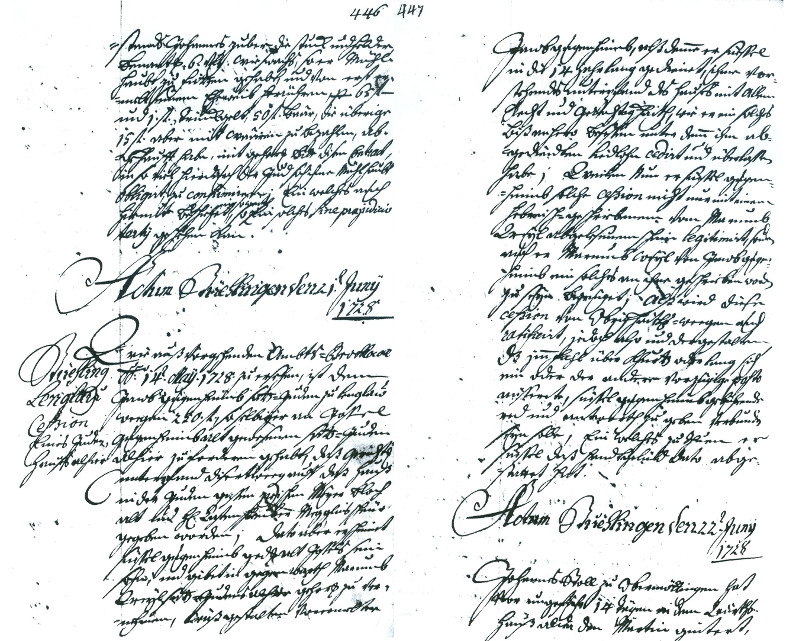Epilogue
¶ 1 Leave a comment on paragraph 1 0 Stühlingen, Lenglau, June 21 1728; Transfer of a Jewish house here:
As can be seen in the protocol of 14. May 1728, Jacob Gugenheimb [G1.3.4] of Lenglau claimed 250 fl. from Jossel Gugenheimb Alt [G1.3.3], former protected Jew here, and a mortgage was inscribed on the house in the Jews´ Lane between Meyer Bloch Alt and clerk Megglin´s barn. Today appears Süssel Guggenheimb [G1.3.3.2], son of said Alt Jossel, and declares in the presence of Marumb Weyl [S1.2.1] that said Jacob Guggenheimb has ceded him, Süssel, this claim as payment for fourteen years of work. This transfer is proven by a Hebrew document, which was translated by Marum Weyl, and by a declaration of Marum that Jacob Guggenheimb has written such to him. Thus, such transfer is officially ratified, but Süssel Guggenheimb will have to respond in case anyone should contest this decision now or in the future. Süssel commits himself by a simple oath. [R2190]
¶ 3
Leave a comment on paragraph 3 0
 Figure 14: Decision protocol of Stühlingen court, June 21 1728, GLA 61/12683. fol. 446/7
Figure 14: Decision protocol of Stühlingen court, June 21 1728, GLA 61/12683. fol. 446/7
¶ 4 Leave a comment on paragraph 4 0 No contest was entered. Siessel1 collected his money, travelled two hundred kilometres to Bavaria, and presented himself two weeks later at the Hürben municipal office to acquire a letter of protection and marry the orphaned Bonle Ullmann. He prospered in Hürben. They had at least six surviving children. The name Guggenheimb or Goggenheimb morphed into Guggenheimer.
¶ 5 Leave a comment on paragraph 5 0 We were able to trace 802 of Siessel’s numerous descendants on five continents. Among them are such pillars of the old German-Jewish establishment in the United States as:
| Randolph Guggenheimer (1848–1907), president of the New York City Board and acting mayor of New York.2 |
| Samuel Untermyer (1858–1940), lawyer, financier, and counsel of a subcommittee of the U.S. House of Representatives Committee on Banking and Currency.3 |
| Norvin R. Lindheim (1880–1928), a counsel involved in the notorious World War I case of the British vessel Appam that had been captured by a German destroyer and brought to the United States, still neutral in 1916 |
| Moses H. Cone (1857–1908), industrialist and philanthropist who built up the Cone textile empire and introduced blue denim used for blue jeans and many other items of clothing.4 |
1In Yiddish (Hebrew letters), the names Siessel and Süssel are indistinguishable.
2Hall, “America’s Successful Men of Affairs.”
3Wikipedia, s.v. “Samuel Untermyer.”
4Wikipedia, s.v. “Moses H. Cone.”

Comments
0 Comments on the whole Page
Login to leave a comment on the whole Page
0 Comments on paragraph 1
Login to leave a comment on paragraph 1
0 Comments on paragraph 2
Login to leave a comment on paragraph 2
0 Comments on paragraph 3
Login to leave a comment on paragraph 3
0 Comments on paragraph 4
Login to leave a comment on paragraph 4
0 Comments on paragraph 5
Login to leave a comment on paragraph 5
0 Comments on paragraph 6
Login to leave a comment on paragraph 6
0 Comments on paragraph 7
Login to leave a comment on paragraph 7
0 Comments on paragraph 8
Login to leave a comment on paragraph 8
0 Comments on paragraph 9
Login to leave a comment on paragraph 9